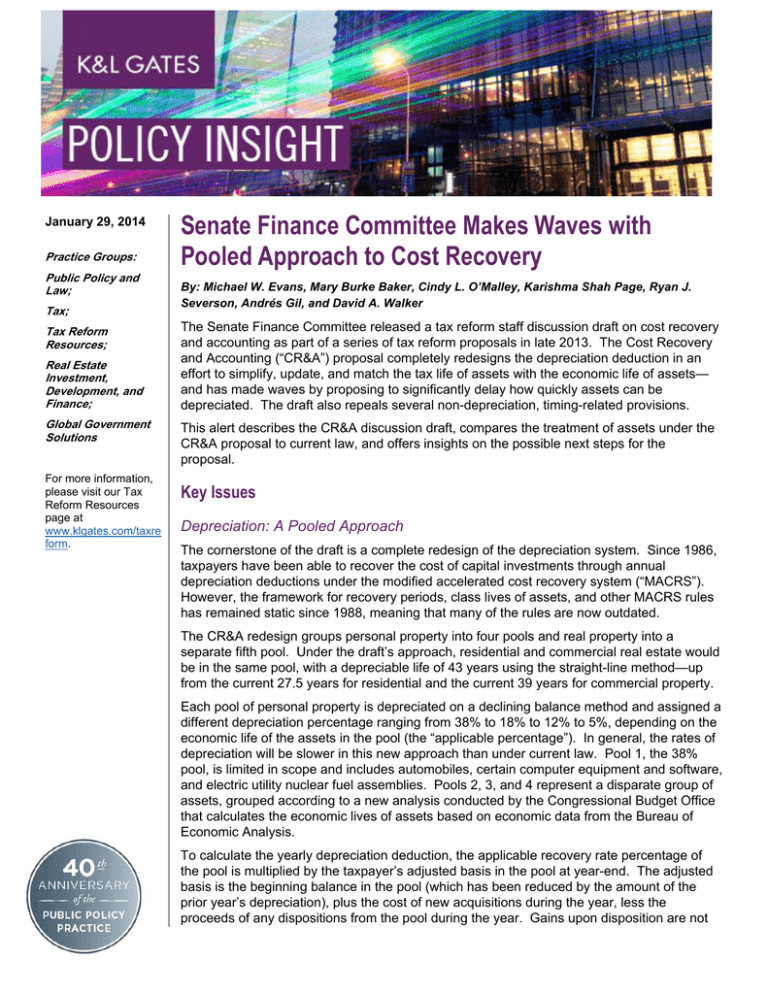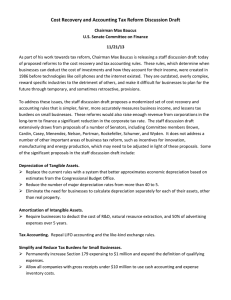Senate Finance Committee Makes Waves with Pooled Approach to Cost Recovery
advertisement

January 29, 2014 Practice Groups: Public Policy and Law; Tax; Tax Reform Resources; Real Estate Investment, Development, and Finance; Global Government Solutions For more information, please visit our Tax Reform Resources page at www.klgates.com/taxre form. Senate Finance Committee Makes Waves with Pooled Approach to Cost Recovery By: Michael W. Evans, Mary Burke Baker, Cindy L. O’Malley, Karishma Shah Page, Ryan J. Severson, Andrés Gil, and David A. Walker The Senate Finance Committee released a tax reform staff discussion draft on cost recovery and accounting as part of a series of tax reform proposals in late 2013. The Cost Recovery and Accounting (“CR&A”) proposal completely redesigns the depreciation deduction in an effort to simplify, update, and match the tax life of assets with the economic life of assets— and has made waves by proposing to significantly delay how quickly assets can be depreciated. The draft also repeals several non-depreciation, timing-related provisions. This alert describes the CR&A discussion draft, compares the treatment of assets under the CR&A proposal to current law, and offers insights on the possible next steps for the proposal. Key Issues Depreciation: A Pooled Approach The cornerstone of the draft is a complete redesign of the depreciation system. Since 1986, taxpayers have been able to recover the cost of capital investments through annual depreciation deductions under the modified accelerated cost recovery system (“MACRS”). However, the framework for recovery periods, class lives of assets, and other MACRS rules has remained static since 1988, meaning that many of the rules are now outdated. The CR&A redesign groups personal property into four pools and real property into a separate fifth pool. Under the draft’s approach, residential and commercial real estate would be in the same pool, with a depreciable life of 43 years using the straight-line method—up from the current 27.5 years for residential and the current 39 years for commercial property. Each pool of personal property is depreciated on a declining balance method and assigned a different depreciation percentage ranging from 38% to 18% to 12% to 5%, depending on the economic life of the assets in the pool (the “applicable percentage”). In general, the rates of depreciation will be slower in this new approach than under current law. Pool 1, the 38% pool, is limited in scope and includes automobiles, certain computer equipment and software, and electric utility nuclear fuel assemblies. Pools 2, 3, and 4 represent a disparate group of assets, grouped according to a new analysis conducted by the Congressional Budget Office that calculates the economic lives of assets based on economic data from the Bureau of Economic Analysis. To calculate the yearly depreciation deduction, the applicable recovery rate percentage of the pool is multiplied by the taxpayer’s adjusted basis in the pool at year-end. The adjusted basis is the beginning balance in the pool (which has been reduced by the amount of the prior year’s depreciation), plus the cost of new acquisitions during the year, less the proceeds of any dispositions from the pool during the year. Gains upon disposition are not Senate Finance Committee Makes Waves with Pooled Approach to Cost Recovery recognized unless the pool has a negative adjusted basis, which will occur when the value of depreciation deductions or dispositions of assets in a pool exceeds the adjusted basis of a pool. The pooling mechanism under the proposal is intended to simplify the depreciation process. However, businesses will still need to decide where to assign specific assets and maintain accurate calculations of their pools—for example, by tracking individual assets. In addition, companies will need to separately account for assets for other purposes. As a result, the pooling mechanism may actually add complexity to the Tax Code. Other Significant Proposals (partial list) • The research and development (“R&D”) deduction is repealed; R&D expenditures must now be capitalized and amortized over five years. The R&D tax credit is not addressed in this draft. • Advertising expenses are 50% deductible in the year incurred, with the remaining 50% amortizable over five years. Advertising expenses are defined broadly in the draft. The five-year period begins midway through the year the expenses are incurred, so the amortization is actually spread over six tax years because the last six months of depreciation falls in the sixth year after costs are incurred. • Percentage depletion rules are repealed. Taxpayers may use cost depletion. • The section 179 expensing for tangible personal property is increased to $1 million, phasing out at $2 million, and is made permanent. The scope of section 179 property is expanded to include R&D expenditures, among others. • The deduction for qualifying film and television productions is repealed. • LIFO and Lower of Cost or Market inventory methods are repealed. • Like-kind exchanges are repealed. Small Businesses/Cash Method of Accounting • Only businesses with average annual gross receipts of $10 million or less over three years are allowed to use the cash basis method of accounting. • Current law exceptions allowing the use of the accrual method of accounting (e.g., personal service corporations) are repealed. • Once a business exceeds the $10 million threshold, it must use the accrual method for the next five years. Even if the business dips below $10 million in a later year, it must stay on the accrual method for another four years before it can switch back to the cash method. 2 Senate Finance Committee Makes Waves with Pooled Approach to Cost Recovery Comparison with Current Law Below is a chart that offers a comparison of how assets are treated under the CR&A proposal with the treatment of these same assets under current law. Finance Committee CR&A Proposal1 Effective Rate Depreciation Rate Year Rate % Year Rate % Recovery Period 1 1 38 5-year 1 20 (generally, information systems, automobiles, electric utility nuclear fuel assemblies) 2 23 2 32 3 14 3 19.2 4 9 4 11.52 5 6 (generally, information systems, automobiles, electric utility nuclear fuel assemblies) 5 11.52 6 5.76 Pool Applicable Rate Current Law (MACRS - Half-Year Convention) 38% 2 6 3 1 18 1 20 2 14 2 32 3 13 3 19.2 2 4 10 4 11.52 (generally, light general purpose trucks, buses, cattle, cutting of timber, telephone comm. equipment) 5 8 5-year 5 11.52 6 6 6 5.76 7 5 8 4 9 4 (generally, light general purpose trucks, buses, cattle, cutting of timber) 10 3 11 2 12 2 13 2 18% 3 Senate Finance Committee Makes Waves with Pooled Approach to Cost Recovery Finance Committee CR&A Proposal Pool Applicable Rate 3 (generally, office furniture, airplanes (noncommercial) and helicopters, vessels, offshore drilling, manufacture of apparel and other finished products, cable television comm. equipment) 12% Effective Rate Year Rate % Current Law (MACRS - Half-Year Convention) Recovery Period Depreciation Rate Year Rate % 7year Rate 10year Rate 1 12 1 14.29 1 10 2 10 2 24.49 2 18 3 9 3 17.49 3 14.4 4 8 4 12.49 4 11.52 5 7 5 8.93 5 9.22 6 6 6 8.92 6 7.37 7 5 7 8.93 7 6.55 8 4.46 8 6.55 9 6.56 10 6.55 11 3.28 Generally 5, 7 or 10-year (5: airplanes (noncommercial) and helicopters, offshore drilling) 8 5 9 4 10 4 11 3 12 3 13 2 (7: office furniture, cable) 14 2 (10: vessels) 15 2 16 2 17 1 18 1 4 Senate Finance Committee Makes Waves with Pooled Approach to Cost Recovery Finance Committee CR&A Proposal Pool Applicable Rate 5% Effective Rate Current Law (MACRS - Half-Year Convention) Recovery Period Depreciation Rate Year Rate % 1 5 1 14.29 1 10 2 5 2 24.49 2 18 3 4 3 17.49 3 14.4 4 4 4 12.49 4 11.52 5 4 5 8.93 5 9.22 6 4 6 8.92 6 7.37 7 4 7 8.93 7 6.55 8 4.46 8 6.55 9 6.56 10 6.55 11 3.28 4 8 3 (generally, railroad cars and locomotives (except those owned by rail 9 3 10 3 11 3 12 3 transport companies), ship and boat building dry docks and land improvements , wind and solar energy structures) 13 3 14 2 15 2 16 2 17 2 18 2 19 2 20 2 21 2 22 2 23 2 24 1 25 1 26 1 Generally 5, 7 or 10-year (5: wind and solar energy structures) Year Rate % (7: railroad cars and locomotives (except those owned by rail transport companies)) (10: ship and boat building dry docks and land improvements) 5 Senate Finance Committee Makes Waves with Pooled Approach to Cost Recovery Finance Committee CR&A Proposal Pool Applicable Rate Effective Rate Year Rate % 27 1 28 1 29 1 30 1 31 1 32 1 33 1 34 .009 35 .009 36 .008 37 .008 38 .007 39 .007 40 .007 41 .006 42 .006 43 .006 44 .005 45 .005 46 .005 Current Law (MACRS - Half-Year Convention) Recovery Period Depreciation Rate Year Rate % Next Steps The Senate Finance Committee considers the CR&A proposal (as well as their discussion drafts on tax administration, international taxes, and energy) to be “starting points” that spark a conversation about tax reform and test whether stakeholders are willing to lose valued tax benefits in exchange for a lower marginal tax rate. Consequently, it is unlikely that the CR&A proposal will be enacted in its current form. However, given the need to update the MACRS system, it is very likely that the CR&A proposal will inspire debate about the U.S. depreciation system in the months to come and may ultimately lead to changes in law. One issue complicating the prospects of the proposal is the expected confirmation of Chairman Max Baucus (D-MT) as the next U.S. Ambassador to China. Senator Ron Wyden 6 Senate Finance Committee Makes Waves with Pooled Approach to Cost Recovery (D-OR), who is widely expected to take the Finance Committee gavel after Chairman Baucus steps down, is deeply committed to tax reform and is likely to continue working with House Ways and Means Committee leadership to enact comprehensive tax reform legislation. However, Senator Wyden may consider discarding some or all of Chairman Baucus’ tax reform proposals in order to put his own stamp on tax reform. As a result, while these dynamics play out, the CR&A proposal is treading water in the Finance Committee. A change in leadership on the Finance Committee will also push back the timing of tax reform significantly, making it much less likely that Congress will pass tax reform legislation in 2014. Still, the proposal embodies ideas that will likely resurface as policymakers continue to examine cost recovery and accounting issues moving forward. Authors: Michael W. Evans Partner michael.evans@klgates.com +1.202.661.3807 Mary Burke Baker Government Affairs Advisor mary.baker@klgates.com +1.202.778.9223 Cindy L. O’Malley Government Affairs Counselor cindy.omalley@klgates.com +1. 202.661.6228 Karishma Shah Page Associate karishma.page@klgates.com +1.202.778.9128 Ryan J. Severson Associate ryan.severson@klgates.com +1.202.778.9251 Andrés Gil Associate andres.gil@klgates.com +1.202.778.9226 David A. Walker Government Affairs Specialist dave.walker@klgates.com +1.202.778.9346 7 Senate Finance Committee Makes Waves with Pooled Approach to Cost Recovery Anchorage Austin Beijing Berlin Boston Brisbane Brussels Charleston Charlotte Chicago Dallas Doha Dubai Fort Worth Frankfurt Harrisburg Hong Kong Houston London Los Angeles Melbourne Miami Milan Moscow Newark New York Orange County Palo Alto Paris Perth Pittsburgh Portland Raleigh Research Triangle Park San Diego San Francisco São Paulo Seattle Seoul Shanghai Singapore Spokane Sydney Taipei Tokyo Warsaw Washington, D.C. Wilmington K&L Gates practices out of 48 fully integrated offices located in the United States, Asia, Australia, Europe, the Middle East and South America and represents leading global corporations, growth and middle-market companies, capital markets participants and entrepreneurs in every major industry group as well as public sector entities, educational institutions, philanthropic organizations and individuals. For more information about K&L Gates or its locations, practices and registrations, visit www.klgates.com. This publication is for informational purposes and does not contain or convey legal advice. The information herein should not be used or relied upon in regard to any particular facts or circumstances without first consulting a lawyer. ©2013 K&L Gates LLP. All Rights Reserved. 1 Assumes $10,000 asset. Under Chairman Baucus’ proposal, when the value of an asset pool is less than $1,000, a taxpayer may choose to fully write off the remaining balance of the asset pool. 2 8





